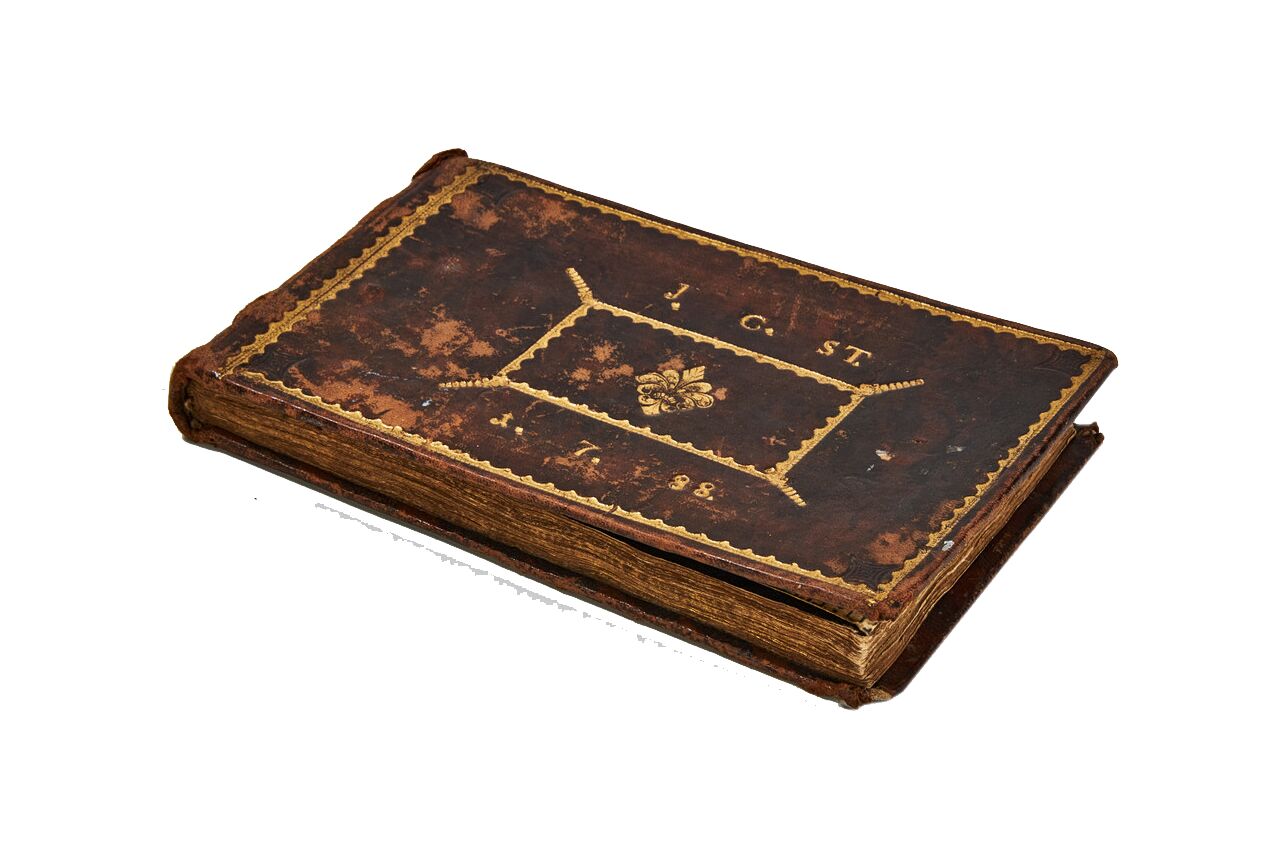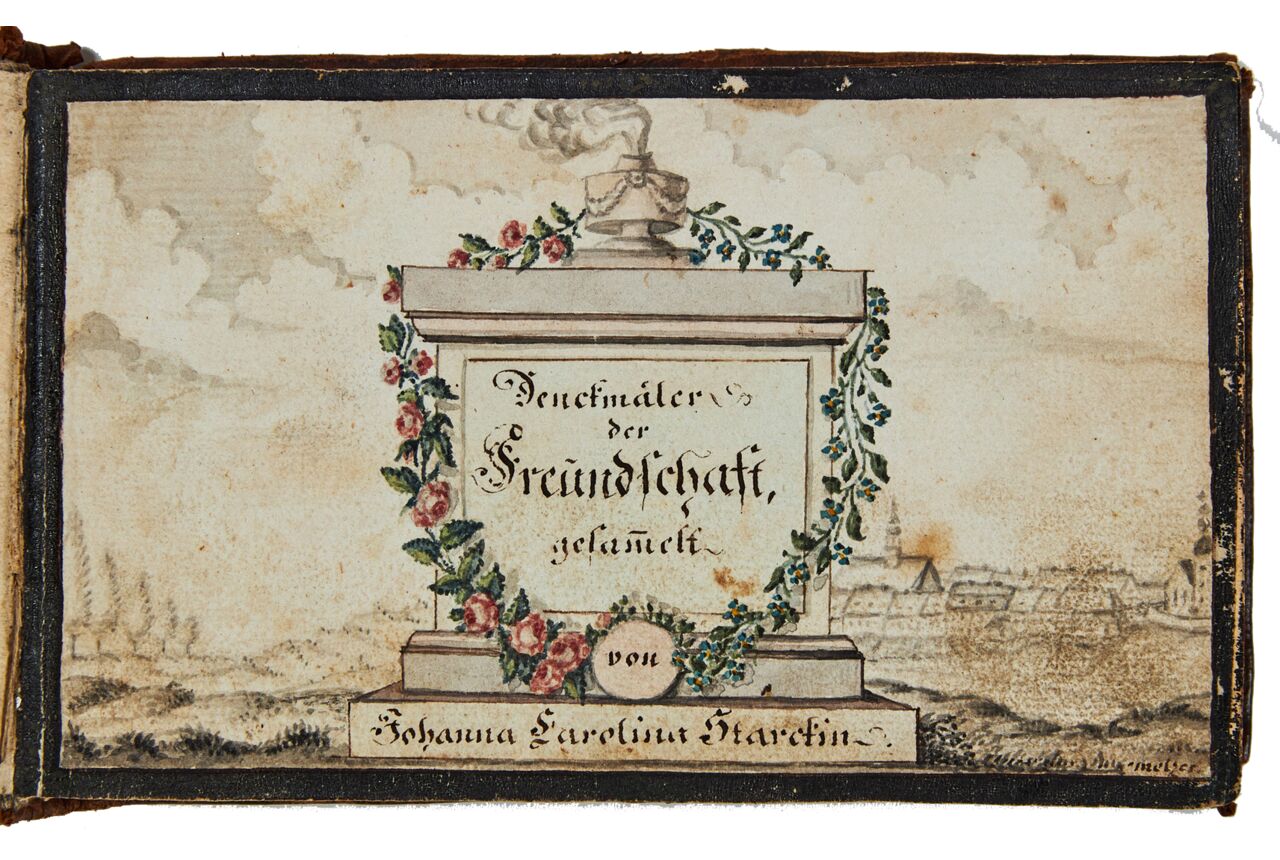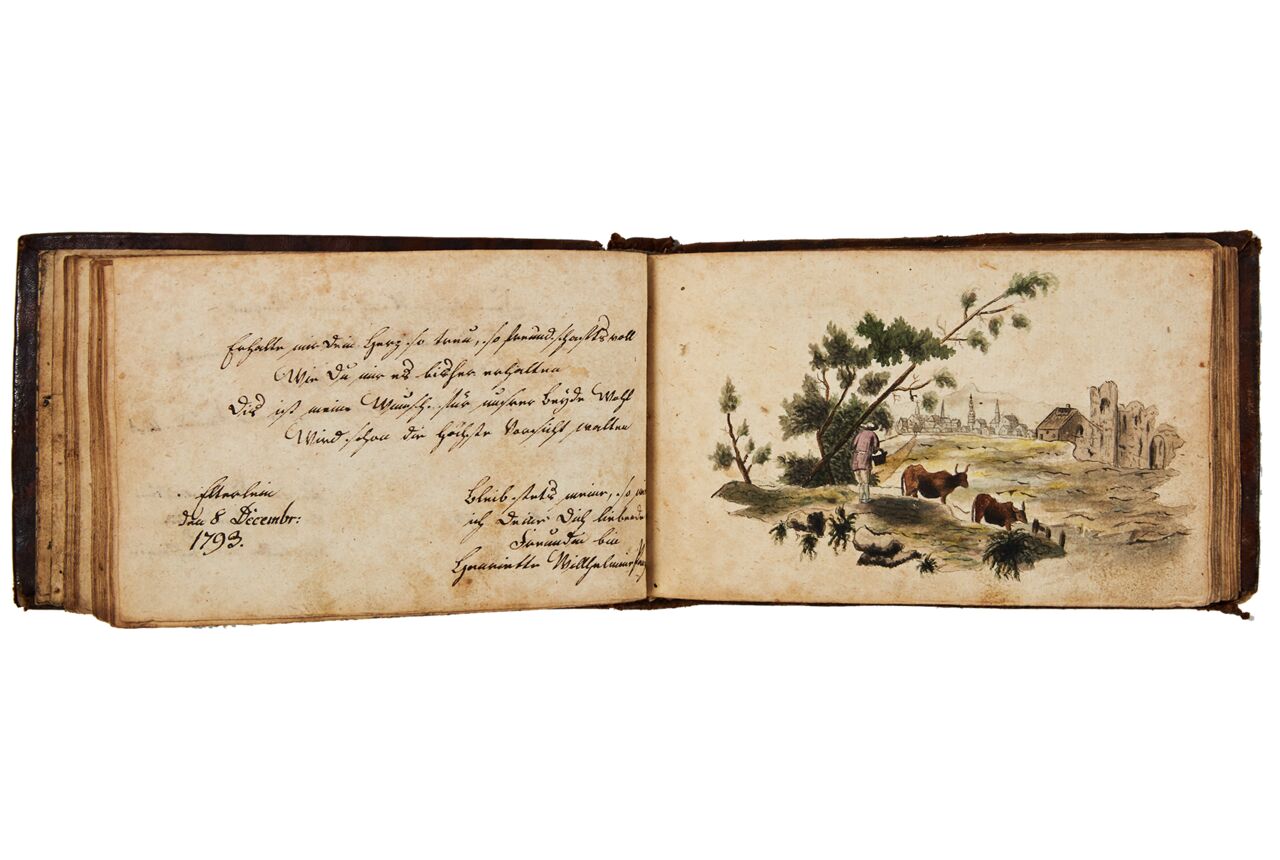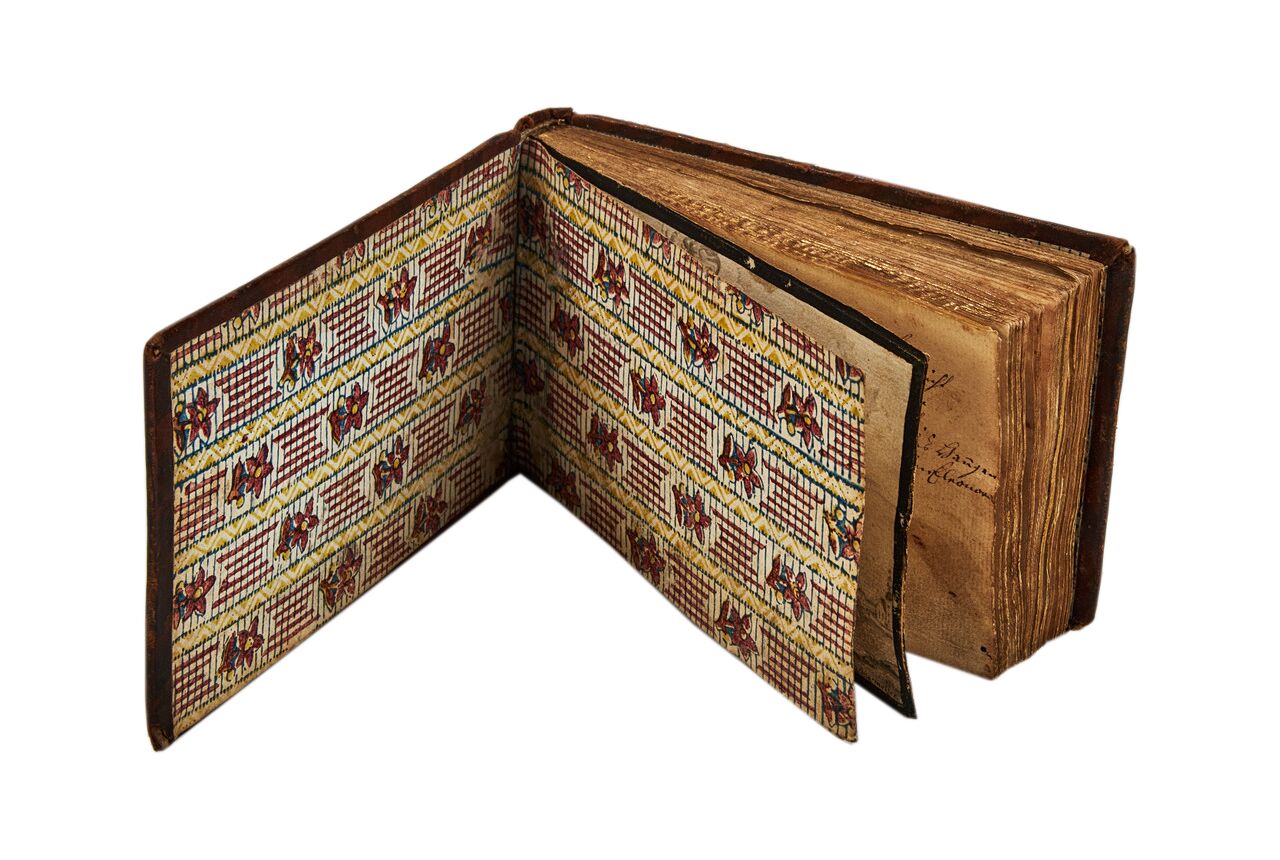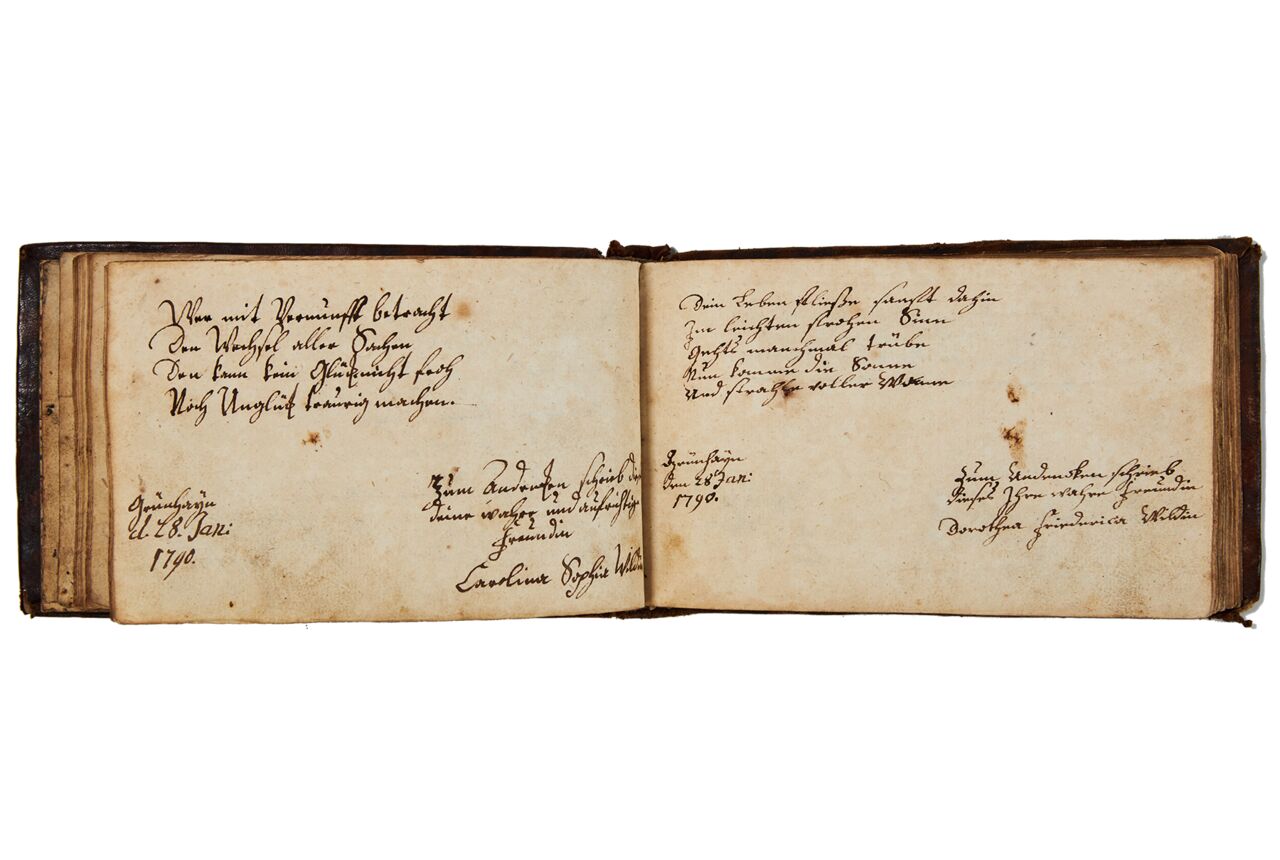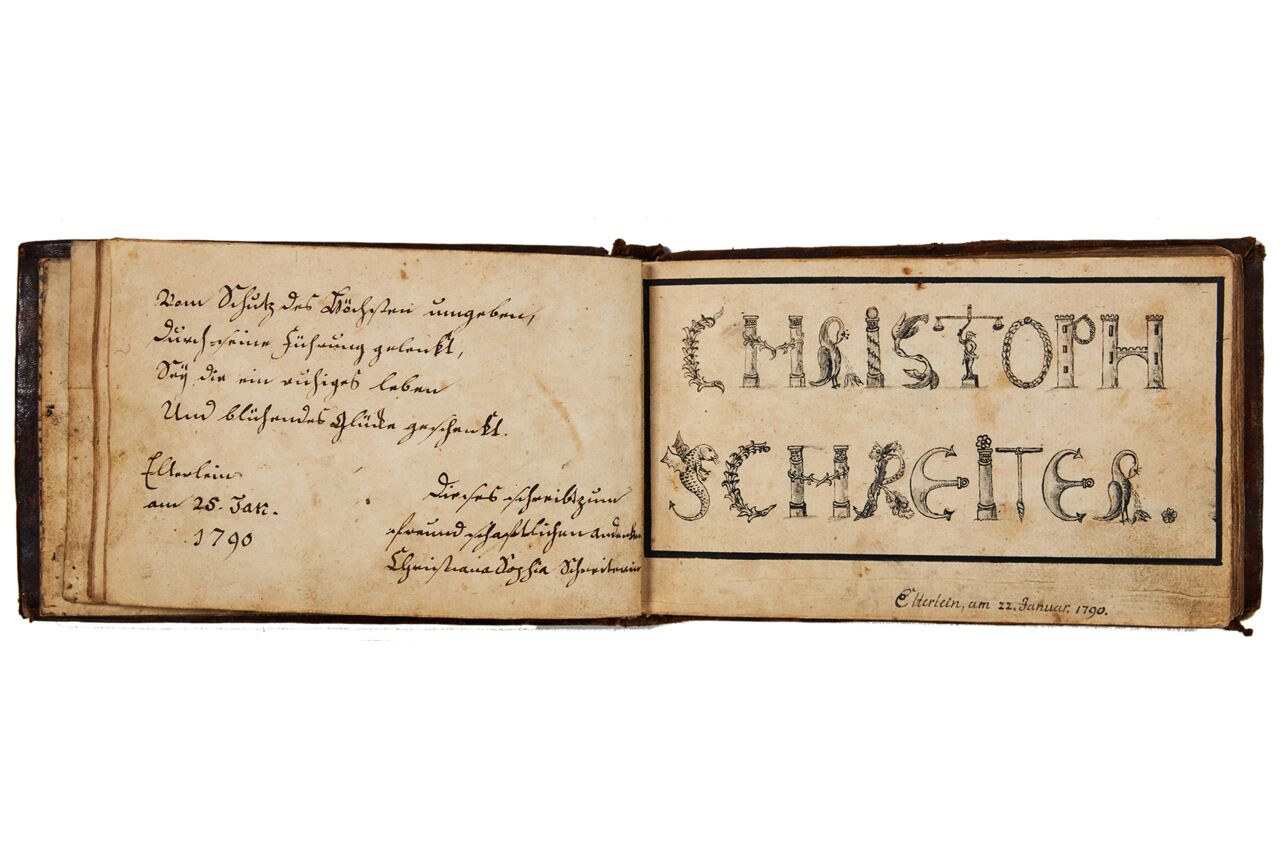i + 74 + i folios on paper, watermark with a coat of arms (unidentified), modern foliation in pencil, 1-73 (including 20bis), FOUR WATERCOLORS, FOUR PEN AND INK DRAWINGS (TWO ENHANCED IN WATERCOLOR), TWO ENGRAVINGS ENHANCED WITH SILK INLAYS BEARING PRINTED POEMS, some minor stains, in overall excellent condition. ORIGINAL BINDING dated 1788 of brown calf over pasteboards, gold tooled on both covers with cusped gold bands framing the outer edges and forming a smaller inner rectangle containing a fleuron, diagonal lines of six beads springing from the corners; above and below the frame gilded initials “J. C. ST.” and date “I. 7. 88.,” spine with two slightly raised bands, gold tooled with cusped bands, gilt edges, patterned endpapers with flower motifs, leather rubbed on the covers and worn at the top of the spine, in overall good condition. Dimensions 101 x 165 mm.
This unrecorded album amicorum, made for a woman, is of a type much less studied than the albums made for men. It provides an interesting insight into women’s social networking within the circles of aristocracy in Saxony at turn of the nineteenth century. The volume collects over 40 souvenirs from her friends and family in Elterlein and Grünhain in Saxony. The entries include fine illustrations, mainly watercolors and pen and ink drawings of funeral monuments and romantic pastoral landscapes, undoubtedly inspired by local views in Saxony.
Provenance
1.This is the album amicorum of Johanna Carolina Starckin, whose name is found on the titlepage on f. 1. Her initials and the date 1788 are in gilt on the cover of the original binding. The entries date between 1788 and 1795, with one addition in 1808 on f. 40.
Text and Illustration
f. 1, Titlepage; pen and ink drawing enhanced in watercolor of a funeral monument topped by a cremation urn in a landscape; the monument is inscribed with the following words: “Denckmäler der Freundschaft gesammelt von Johanna Carolina Starckin” (Monuments of Friendship collected by Johanna Carolina Starckin); garlands of roses and forget-me-not flowers drape the monument and urn; the urn with flame symbolizes undying remembrance; black painted frame; signed “melzer” in the bottom right corner, cf. entry by Johann Melzer on f. 15;
f. 4, Watercolor representing a cave in a mountain with three crosses; a river runs by the cave, a hillock and a willow; presumably by the same person who entered the poem on the facing page f. 3v dated “Elterlein, den 3. Oct 1794”;
f. 10, Pen and ink calligraphic drawing representing the name Christoph Schreiter; the letters take the forms of garlands, birds, a dragon, anchors, classical columns, turrets, and a sculpture representing the allegorical figure of Justice holding scales; dated “Elterlein, am 22. Januar. 1790.”;
f. 15, Entry by Johann Wilhelm Emanuel Melzer with a triangular section of a watercolor landscape revealed behind a trompe-l’oeil turned-down corner of the page; dated “Grünhain den 8. Decbr. 1790”;
f. 30, Pen and ink drawing enhanced in watercolor in gray tones, representing a funeral monument in a landscape, presumably by the person who entered a poem on the facing page f. 29v dated “Elterlein den 8. December 1793”; a stele with the outline of the border of Saxony is leaning against the monument;
f. 32, Watercolor of a country landscape with a field of cows, a figure seen from the back walking on a path with a basket, trees on the left, castle ruins on the right, and a town in the far distance;
f. 39, Watercolor of three playing cards placed on top of each other, the suit of hearts at the top of the pile; presumably by “C. F. P.” who signed the poem entered on the facing page f. 38v, dated “Elterlein 8 Dec. 1793”;
f. 43v, Engraving enhanced in watercolor, including an embedded section in silk; the engraving represents the allegorical figure of Hope standing by a funeral monument; the Roman stola of Hope, her symbol, the anchor, the rose garland, the monument and the cremation urn are painted in watercolor; the section with the inscription inside the garland has been cut out and replaced by a poem printed on pink silk: “Walle burch birss Erbenleben...”; the engraving is pasted onto the page; presumably entered by the same person who dated an entry “Elterlein am 30 Aug 1794” on the facing page f. 44;
f. 63v, Very fine pen and ink drawing in red ink representing a funeral monument; a seated putto, flowers and a large decorated cremation urn crown the monument; signed “bei I. G. Büttner”; a frame made of blue paper was pasted around the drawing; pasted onto the page next to an entry dated “den 6 oct In Jaher 1794”;
f. 71, Entry with a drawing of a grid including 8 columns and 6 lines, with one word in each cell; the words form a poem(?); read horizontally it begins “Wars aus ihm viel Recht...”; signed Christian Sottlob Tauscher;
[Back pastedown], Engraving enhanced in watercolor, embedded with a section in silk; the scene represents a funeral monument in a landscape with a waterfall, ruins, trees and a river; the original inscription on the funeral monument has been cut out and replaced by a poem printed on light blue silk: “Heil Dir, Theure, immer müsse...”;
Other entries include poems entered by Christian Göttlieb Gottschald (f. 5), Johanna Wilhelmina Gottschald (f. 6), M. C. Günther (f. 16), Carl August Bielitz (f. 17v), Ludwig Siekert (f. 23), and others. There are entries on ff. 1, 2 (the first entry dated “am 1 Oct 1788,” beginning “Für dich...”), 3v-4, 5, 6, 7v-8, 9v-10, 11, 12, 13, 14, 15, 16, 17v-18, 19, 20, 20bis, 21, 22-23, 24, 25-26, 27, 28, 29v-30, 31-32, 33, 34v-35, 38v-39, 40, 43v-44, 55v-57, 63v, 70v-71, 72, 73v, and back pastedown; the other pages are blank.
This album provides original eighteenth-century material for studying social history in Saxony in eastern Germany. The entries are witty and charming, while the illustrations offer interesting examples of works in mixed media, combining copper engraving, watercolor and printing on silk. The pictorial alphabet explores the relationships of text and image, while the grid poem plays on the presentation of text on the page. Many of the entries in our manuscript are by members of the illustrious Gottschald family of Saxony.
The album amicorum, or album of friends, is a booklet in which young aristocrats collected entries made by their friends and relatives. On the pages of the Stammbuch, as it was called in German, friends would usually offer poems, wishes, drawings and watercolors, signed with a date and current location. The album amicorum was popular from the sixteenth until the nineteenth century. It was initially favored by men in aristocratic, bourgeois and university circles, and entries were collected from acquaintances met during travels and studies. However, at the beginning of the nineteenth century, the albums were increasingly made for women (alba amicorum for women in the sixteenth and seventeenth centuries in the Low Countries have been studied by Sophie Reinders, 2016, 2017). The decoration was adapted accordingly, and the entries were collected more locally from among the closest family members and friends. The entries in our manuscript were made in Elterlein and Grünhain, only about six kilometers distance from each other. The albums made for women were more intimate, and no longer served as collections of remembrances of fellow students or prized inscriptions written by great scholars of one’s time. Many of the entries inscribed in our manuscript are by women.
Throughout their history, the albums usually assumed an elongated horizontal format, as is the case for our manuscript. The album amicorum is central in modern transdisciplinary research studying texts, reception and collecting in cultural and social contexts and the history of mentalities; see especially the comprehensive study by Werner Wilhelm Schnabel published in 2003.
Literature
Fechner, J.-U. ed. Stammbücher als kulturhistorische Quellen, Wolfenbütteler Forschungen, 11, Munich, 1981.
Keil, R. and R. Die deutschen Stammbücher des sechzehnten bis neunzehnten Jahrhunderts. Ernst und Scherz, Weisheit und Schwank in Original-Mittheilungen zur deutschen Kultur-Geschichte, Berlin, 1893 (reprint Hildesheim, 1975).
Klose, W. “Stammbücher: eine kulturhistorische Betrachtung,” Bibliothek und Wissenschaft 16 (1982), pp. 41-67.
Kurras, L. Zu gutem Gedenken. Kulturhistorische Miniaturen aus Stammbüchern des Germanischen Nationalmuseums 1570-1770, Munich, 1987.
Lilienthal, M. Schediasma critico-literarium de philiothecis varioque earundum usu et abusu, vulgo von Stamm-Büchern, Königsberg, 1712; rev. Wittenberg, 1740 (repr. in Fechner, 1981, pp. 237-298). [the first study of Alba Amicorum].
Nickson, M.A.E. Early Autograph Albums in the British Museum, London, Trustees of the British Museum, 1970.
Reinders, Sophie. De mug en de kaars. Vriendenboekies van adellijke vrouwen, 1575-1640, Nijmgen, 2017.
(Summary of her dissertation (English) https://www.academia.edu/35402416/Summary_docx)
Reinders, Sophie. “Social Networking is in Our DNA: Women’s Alba Amicorum as Places to Build and Affirm Group Identities,” in Dieuwke Van Der Poel, Louis P. Grijp, and Wim van Anrooij, eds. Identity, Intertextuality, and Performance in Early Modern Song Culture, Leiden, 2016, p. 150-177.
https://brill.com/display/book/9789004314986/B9789004314986_007.xml
Rosenheim, M. The album amicorum, Oxford, 1910.
Schnabel, W. W. Das Stammbuch: Konstitution und Geschichte einer textsortenbezogenen Sammelform bis ins erste Drittel des 18. Jahrhunderts, Berlin, 2003.
Schünemann, H. “Stammbücher,” Schrifttumsberichte zur Genealogie und zu ihren Nachbargebieten 2 (1965), pp. 67-108.
Taegert, W. Edler Schatzholden Erinnerns: Bilder in Stammbüchern der Staatsbibliothek Bamberg aus vier Jahrhunderten, Bamberg, 1995.
Thomassen, K., ed. Alba amicorum. Vijf eeuwen vriendscap op papier gezet. Het album amicorum en het poëziealbum in de Nederlanden, Maarssen/The Hague, 1990.
Wilson, Brownwen. “Social Networking: the “album amicorum” and early modern public-making,” in Beyond the Public Sphere, ed. Massimo Rochpocher, Berlin and Bologna, 2012, pp. 205-227.
https://www.academia.edu/5964380/Social_Networking_the_album_amicorum_and_early_modern_public_making
Online Resources
Repertorium Alborum Amicorum (RAA) https://raa.gf-franken.de/de/startseite.html
(our manuscript is not recorded)
Suzanne Karr Schmidt, “Eighteenth-century Social Networking,” October 21, 2021
18th-Century Social Networking | Newberry Library
TM 1287


